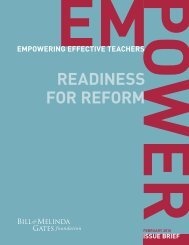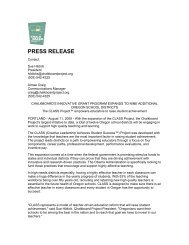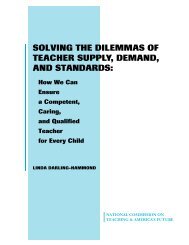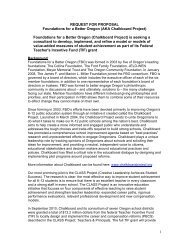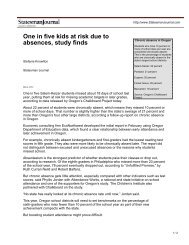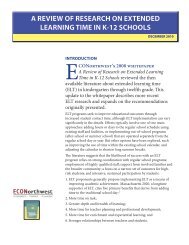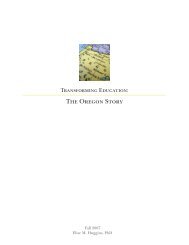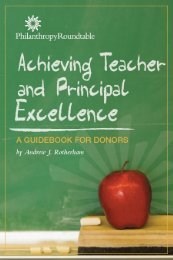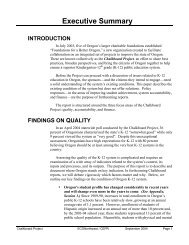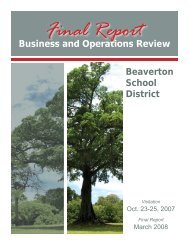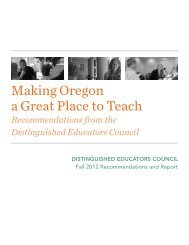Tapping the Potential - Alliance for Excellent Education
Tapping the Potential - Alliance for Excellent Education
Tapping the Potential - Alliance for Excellent Education
Create successful ePaper yourself
Turn your PDF publications into a flip-book with our unique Google optimized e-Paper software.
A L L I A N C E F O R E X C E L L E N T E D U C AT I O NEndnotes1 Kevin Carey, The Real Value of Teachers(Washington, D.C.: <strong>Education</strong> Trust, 2004).2 Frederick Hess, Andrew Ro<strong>the</strong>rham, andKate Walsh, eds., A Qualified Teacher in EveryClassroom? Appraising Old Answers and NewIdeas (Cambridge, MA: Harvard UniversityPress, 2004).3 The Morrill Act encouraged all states toestablish land-grant universities. More thanseventy land-grant colleges were established,with Vermont and New York among <strong>the</strong> firststates to do so. A second act in 1890, specificallyaddressing <strong>the</strong> needs of AfricanAmericans, said that no state could receivefunds if it denied access to college on <strong>the</strong>basis of race, unless a state also established“separate but equal” facilities <strong>for</strong> excludedraces. Seventeen sou<strong>the</strong>rn states thus establishedblack land-grant colleges.4 The Smith-Hughes National Vocational<strong>Education</strong>al Act of 1917 promoted vocationalagriculture and provided federal funds <strong>for</strong>that purpose; to receive funds, states wererequired to establish a plan that included“plans <strong>for</strong> <strong>the</strong> training of teachers.”5 Hess, Ro<strong>the</strong>rham, and Walsh, A QualifiedTeacher in Every Classroom?6 James Coleman, Equality of <strong>Education</strong>alOpportunity (Washington, D.C.: U.S. Dept.of Health, <strong>Education</strong>, and Welfare, Officeof <strong>Education</strong>, 1966).7 Christopher Jencks, Inequality: AReassessment of <strong>the</strong> Effect of Family andSchooling in America (San Francisco: BasicBooks, 1972).8 Marisol Definao and James Hoffman, AStatus Report and Content Analysis of StateMandated Teacher Induction Programs(Austin, TX: Texas University Research andDevelopment Center <strong>for</strong> Teacher<strong>Education</strong>, 1984).9 Barbara Heyns, “<strong>Education</strong>al Defectors: AFirst Look at Teacher Attrition in <strong>the</strong> NLS-72,” <strong>Education</strong>al Researcher 17:3 (1988).10 “Trans<strong>for</strong>ming a Nation at Risk into aNation Prepared,” Carnegie Results 1:3(2003).11 Gary A. Griffin, “Teacher Induction:Research Issues,” Journal of Teacher<strong>Education</strong> 36:1 (1985).12 Sandra Odell, Mentor Teacher Programs(Washington, D.C.: National <strong>Education</strong>Association, 1990).13 Sandra Odell and Douglas Ferraro,“Teacher Mentoring and TeacherRetention,” Journal of Teacher <strong>Education</strong> 43:3(1992).14 What Matters Most: Teaching <strong>for</strong> America’sFuture (New York: National Commission onTeaching and America’s Future, 1996).15 Richard Ingersoll and Thomas Smith,“Do Teacher Induction and MentoringMatter?,” paper presented at <strong>the</strong> AnnualMeeting of <strong>the</strong> American <strong>Education</strong>alResearch Association Annual Meeting,Chicago, 21–25 April 2003.16 Schools and Staffing in <strong>the</strong> United States1993–94 (Washington, D.C.: U.S.Department of <strong>Education</strong>, National Center<strong>for</strong> <strong>Education</strong> Statistics, 1996).17 Quality Counts 2004: Count Me In(Be<strong>the</strong>sda, MD: Editorial Projects in<strong>Education</strong>, 2004).18 Chester Finn Jr., “A Nation Still at Risk,”Commentary (May 1989).19 Julian E. Barnes, “Now <strong>the</strong> Focus Shiftsfrom Integration to Achievement <strong>for</strong> All,”U.S. News & World Report, March 22–29,2004.20 Richard Ingersoll, Is There Really aTeacher Shortage? (Seattle: Center <strong>for</strong> <strong>the</strong>Study of Teaching and Policy, 2003) withanalysis by <strong>the</strong> <strong>Alliance</strong> <strong>for</strong> <strong>Excellent</strong><strong>Education</strong>.21 The Department of Labor estimates thatattrition costs an employer 30 percent of<strong>the</strong> leaving employee’s salary. Usingnational data from <strong>the</strong> NationalCommission on Teaching and America’sFuture, <strong>the</strong> <strong>Alliance</strong> <strong>for</strong> <strong>Excellent</strong><strong>Education</strong> estimates that each teacher leavinga school costs <strong>the</strong> district $12,546.(Average teacher salary in 1999–00 =$41,820 x .30 = $12,546.) In <strong>the</strong> 1999–00school year, approximately 207,370 teachersleft <strong>the</strong> profession, not includingretirees. Thus, <strong>the</strong> number of leavingteachers (207,370) multiplied by <strong>the</strong> averagecost of attrition ($12,546) yields <strong>the</strong>total cost of attrition at $2.6 billion($2,601,664,020).22 Ingersoll, Is There Really a Teacher Shortage?23 Anthony Villar, Measuring <strong>the</strong> Benefits andCosts of Mentor-Based Induction: A Value-Added Assessment of New Teacher EffectivenessLinked to Student Achievement (Santa Cruz,CA: New Center, 2004).24 Thomas Smith and Richard Ingersoll,“What Are <strong>the</strong> Effects of Induction andMentoring on Beginning TeacherTurnover?” American <strong>Education</strong>al ResearchJournal 41:2 (Summer 2004).25 David Berliner, “A Personal Response toThose Who Bash Teacher <strong>Education</strong>,”Journal of Teacher <strong>Education</strong> 51:5(November/December 2000). OmarLopez, “Classroom Diversification: AnAlternative Paradigm <strong>for</strong> Research in<strong>Education</strong>al Productivity,” Ph.D. diss.,University of Texas at Austin, 1995. CarlaClaycomb and Willis D. Hawley, Recruitingand Retaining Effective Teachers <strong>for</strong> UrbanSchools (National Partnership <strong>for</strong>Excellence and Accountability in Teaching,March 2000).26 Anthony Villar, Measuring <strong>the</strong> Benefits andCosts of Mentor-Based Induction.27 Smith and Ingersoll, “What Are <strong>the</strong>Effects of Induction and Mentoring onBeginning Teacher Turnover?”28 Beyond Islands of Excellence: What DistrictsCan Do to Improve Instruction and Achievementin All Schools (Washington, D.C.: LearningFirst <strong>Alliance</strong>, 2003). Susan Kardos, “NewTeachers’ Experiences of Mentoring,64



